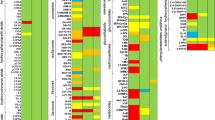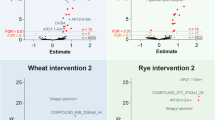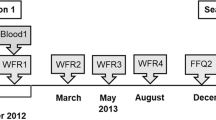Abstract
Background/Objectives
Dietary intake of red and processed meat has been associated with disease risk. Since dietary intake assessment methods are prone to measurement errors, identifying biomarkers of meat intake in bio-samples could provide more valid intake estimates. We examined associations of habitual red and processed meat, poultry, fish, and dairy products consumption with plasma concentrations of anserine, carnosine, pi-methylhistidine (Π-MH), tau-methylhistidine (T-MH), and the ratio of T-MH to Π-MH in a cross-sectional study.
Subjects/Methods
Plasma anserine, carnosine, Π-MH, and T-MH concentrations were measured using ion-pair LC–MS/MS in 294 participants in the second Bavarian Food Consumption Survey (BVS II). Habitual food consumption was assessed using three 24-h dietary recalls. Associations between plasma metabolites concentrations and meat, fish, eggs, and dairy products consumption were assessed by fitting generalized linear model, adjusted for age, sex, and BMI.
Results
Total meat intake was associated with plasma concentrations of anserine, carnosine, Π-MH and, the ratio of T-MH to Π-MH. Red meat intake was related to carnosine (p-trend = 0.0028) and Π-MH plasma levels (p-trend = 0.0493). Poultry (p-trend = 0.0006) and chicken (p-trend = 0.0003) intake were associated with Π-MH. The highest anserine concentrations were observed in individuals consuming processed meat or turkey. For T-MH we did not observe any association with meat intake.
Conclusions
Our results indicate an association between habitual meat consumption and plasma concentrations of anserine, carnosine, Π-MH and the ratio of T-MH to Π-MH. Intervention studies should clarify whether the analyzed plasma metabolites are indicative for a specific type of meat before proposing them as biomarkers of habitual meat intake in epidemiologic studies.
This is a preview of subscription content, access via your institution
Access options
Subscribe to this journal
Receive 12 print issues and online access
$259.00 per year
only $21.58 per issue
Buy this article
- Purchase on Springer Link
- Instant access to full article PDF
Prices may be subject to local taxes which are calculated during checkout
Similar content being viewed by others
References
Abete I, Romaguera D, Vieira AR, Lopez de Munain A, Norat T. Association between total, processed, red and white meat consumption and all-cause, CVD and IHD mortality: a meta-analysis of cohort studies. Br J Nutr. 2014;112:762–75. https://doi.org/10.1017/S000711451400124X
Chen GC, Lv DB, Pang Z, Liu QF. Red and processed meat consumption and risk of stroke: a meta-analysis of prospective cohort studies. Eur J Clin Nutr. 2013;67:91–95. https://doi.org/10.1038/ejcn.2012.180
Dragsted LO. Biomarkers of meat intake and the application of nutrigenomics. Meat Sci. 2010;84:301–7. https://doi.org/10.1016/j.meatsci.2009.08.028
Micha R, Wallace SK, Mozaffarian D. Red and processed meat consumption and risk of incident coronary heart disease, stroke, and diabetes mellitus: a systematic review and meta-analysis. Circulation. 2010;121:2271–83. https://doi.org/10.1161/CIRCULATIONAHA.109.924977
Chan DS, Lau R, Aune D, Vieira R, Greenwood DC, Kampman E, et al. Red and processed meat and colorectal cancer incidence: meta-analysis of prospective studies. PLoS ONE. 2011;6:e20456 https://doi.org/10.1371/journal.pone.0020456
Rohrmann S, Linseisen J. Processed meat: the real villain? Proc Nutr Soc. 2016;75:233–41. https://doi.org/10.1017/S0029665115004255
Rohrmann S, Overvad K, Bueno-de-Mesquita HB, Jakobsen MU, Egeberg R, Tjonneland A, et al. Meat consumption and mortality–results from the European Prospective Investigation into Cancer and Nutrition. BMC Med. 2013;11:63 https://doi.org/10.1186/1741-7015-11-63
Shim JS, Oh K, Kim HC. Dietary assessment methods in epidemiologic studies. Epidemiol Health. 2014;36:e2014009 https://doi.org/10.4178/epih/e2014009
Biro G, Hulshof KF, Ovesen L, Amorim Cruz JA, Group E. Selection of methodology to assess food intake. Eur J Clin Nutr. 2002;56:S25–32. https://doi.org/10.1038/sj.ejcn.1601426
Kipnis V, Subar AF, Midthune D, Freedman LS, Ballard-Barbash R, Troiano RP, et al. Structure of dietary measurement error: results of the OPEN biomarker study. Am J Epidemiol. 2003;158:14–21.
Turunen AW, Mannisto S, Kiviranta H, Marniemi J, Jula A, Tiittanen P, et al. Dioxins, polychlorinated biphenyls, methyl mercury and omega-3 polyunsaturated fatty acids as biomarkers of fish consumption. Eur J Clin Nutr. 2010;64:313–23. https://doi.org/10.1038/ejcn.2009.147
Sjolin J, Hjort G, Friman G, Hambraeus L. Urinary excretion of 1-methylhistidine: a qualitative indicator of exogenous 3-methylhistidine and intake of meats from various sources. Metabolism. 1987;36:1175–84.
Potischman N. Biologic and methodologic issues for nutritional biomarkers. J Nutr. 2003;133:875S–80S.
Altorf-van der Kuil W, Brink EJ, Boetje M, Siebelink E, Bijlsma S, Engberink MF, et al. Identification of biomarkers for intake of protein from meat, dairy products and grains: a controlled dietary intervention study. Br J Nutr. 2013;110:810–22. https://doi.org/10.1017/S0007114512005788
International Union of Pure and Applied Chemists. IUPAC Gold Book [cited August 2017].
Himmerich SGK, Karg G. Bayerische Verzehrsstudie (BVS) II-Abschlussbericht [Second Bavarian Food Consumption Survey- Final report], Bayerisches Staastministerium fuer Umwelt, Gesundheit und Verbrauchschutz (in German); 2003.
Slimani N, Deharveng G, Charrondiere RU, van Kappel AL, Ocke MC, Welch A, et al. Structure of the standardized computerized 24-h diet recall interview used as reference method in the 22 centers participating in the EPIC project. European Prospective Investigation into Cancer and Nutrition. Comput Methods Prog Biomed. 1999;58:251–66.
Voss S, Charrondiere UR, Slimani N, Kroke A, Riboli E, Wahrendorf J, et al. EPIC-SOFT a European computer program for 24-hour dietary protocols. Z Ernahr. 1998;37:227–33.
Himmerich H, Fulda S, Linseisen J, Seiler H, Wolfram G, Himmerich S, et al. TNF-alpha, soluble TNF receptor and interleukin-6 plasma levels in the general population. Eur Cytokine Netw. 2006;17:196–201.
Harder U, Koletzko B, Peissner W. Quantification of 22 plasma amino acids combining derivatization and ion-pair LC–MS/MS. J Chromatogr B Anal Technol Biomed Life Sci. 2011;879:495–504. https://doi.org/10.1016/j.jchromb.2011.01.010
Gucciardi A, Pirillo P, Di Gangi IM, Naturale M, Giordano G. A rapid UPLC-MS/MS method for simultaneous separation of 48 acylcarnitines in dried blood spots and plasma useful as a second-tier test for expanded newborn screening. Anal Bioanal Chem. 2012;404:741–51. https://doi.org/10.1007/s00216-012-6194-1
Gil-Agusti M, Esteve-Romero J, Carda-Broch S. Anserine and carnosine determination in meat samples by pure micellar liquid chromatography. J Chromatogr A. 2008;1189:444–50. https://doi.org/10.1016/j.chroma.2007.11.075
Yeum KJ, Orioli M, Regazzoni L, Carini M, Rasmussen H, Russell RM, et al. Profiling histidine dipeptides in plasma and urine after ingesting beef, chicken or chicken broth in humans. Amino Acids. 2010;38:847–58. https://doi.org/10.1007/s00726-009-0291-2
Abe H, Okuma E, Sekine H, Maeda A, Yoshiue S. Human urinary excretion of L-histidine-related compounds after ingestion of several meats and fish muscle. Int J Biochem. 1993;25:1245–9.
Cross AJ, Major JM, Sinha R. Urinary biomarkers of meat consumption. Cancer Epidemiol Biomark Prev. 2011;20:1107–11. https://doi.org/10.1158/1055-9965.EPI-11-0048
Datta SP, Harris H. Dietary origin of urinary methylhistidine. Nature. 1951;168:296–7.
Myint T, Fraser GE, Lindsted KD, Knutsen SF, Hubbard RW, Bennett HW. Urinary 1-methylhistidine is a marker of meat consumption in Black and in White California Seventh-day Adventists. Am J Epidemiol. 2000;152:752–5.
Cheung W, Keski-Rahkonen P, Assi N, Ferrari P, Freisling H, Rinaldi S, et al. A metabolomic study of biomarkers of meat and fish intake. Am J Clin Nutr. 2017;105:600–8. https://doi.org/10.3945/ajcn.116.146639
Rohrmann S, Linseisen J, Allenspach M, von Eckardstein A, Muller D. Plasma concentrations of Trimethylamine-N-oxide are directly associated with dairy food consumption and low-grade inflammation in a German Adult Population. J Nutr. 2016;146:283–9. https://doi.org/10.3945/jn.115.220103
Park YJ, Volpe SL, Decker EA. Quantitation of carnosine in humans plasma after dietary consumption of beef. J Agric Food Chem. 2005;53:4736–9. https://doi.org/10.1021/jf047934h
Gardner ML, Illingworth KM, Kelleher J, Wood D. Intestinal absorption of the intact peptide carnosine in man, and comparison with intestinal permeability to lactulose. J Physiol. 1991;439:411–22.
Wawro N, Kleiser C, Himmerich S, Gedrich K, Boeing H, Knueppel S, et al. Estimating Usual Intake in the 2nd Bavarian Food Consumption Survey: Comparison of the Results Derived by the National Cancer Institute Method and a Basic Individual Means Approach. Ann Nutr Metab. 2017;71:164–74. https://doi.org/10.1159/000481148
Yin X, Gibbons H, Rundle M, Frost G, McNulty BA, Nugent AP et al. Estimation of chicken intake by adults using metabolomics-derived markers. J Nutr. 2017. https://doi.org/10.3945/jn.117.252197
Thompson FE, Kirkpatrick SI, Subar AF, Reedy J, Schap TE, Wilson MM, et al. The National Cancer Institute’s Dietary Assessment Primer: a resource for diet research. J Acad Nutr Diet. 2015;115:1986–95. https://doi.org/10.1016/j.jand.2015.08.016
Slimani N, Bingham S, Runswick S, Ferrari P, Day NE, Welch AA, et al. Group level validation of protein intakes estimated by 24-hour diet recall and dietary questionnaires against 24-hour urinary nitrogen in the European Prospective Investigation into Cancer and Nutrition (EPIC) calibration study. Cancer Epidemiol Biomark Prev. 2003;12:784–95.
Crispim SP, de Vries JH, Geelen A, Souverein OW, Hulshof PJ, Lafay L, et al. Two non-consecutive 24 h recalls using EPIC-Soft software are sufficiently valid for comparing protein and potassium intake between five European centres--results from the European Food Consumption Validation (EFCOVAL) study. Br J Nutr. 2011;105:447–58. https://doi.org/10.1017/S0007114510003648
Acknowledgements
The second Bavarian Food Consumption survey (Bayerische Verzehrsstudie II) study was supported by funds of the Bavarian Ministry of Environment, Health and Consumer Protection and the Kurt-Eberhard-Bode-Stiftung. Support for this specific project was provided by The Food Biomarkers Alliance Project FOODBALL (German Ministry for Education and Research, FK 2814ERA02E), a project in the context of the EU Joint Programming Initiative “A Healthy Diet for a Healthy Life”.
Author information
Authors and Affiliations
Corresponding author
Ethics declarations
Conflict of interest
The authors declare that they have no conflict of interest.
Electronic supplementary material
Rights and permissions
About this article
Cite this article
Mitry, P., Wawro, N., Rohrmann, S. et al. Plasma concentrations of anserine, carnosine and pi-methylhistidine as biomarkers of habitual meat consumption. Eur J Clin Nutr 73, 692–702 (2019). https://doi.org/10.1038/s41430-018-0248-1
Received:
Revised:
Accepted:
Published:
Issue Date:
DOI: https://doi.org/10.1038/s41430-018-0248-1
This article is cited by
-
Stable isotope ratios of nitrogen and carbon as biomarkers of a vegan diet
European Journal of Nutrition (2023)
-
Plasma metabolites associated with chronic kidney disease and renal function in adults from the Baltimore Longitudinal Study of Aging
Metabolomics (2021)
-
The anserine to carnosine ratio: an excellent discriminator between white and red meats consumed by free-living overweight participants of the PREVIEW study
European Journal of Nutrition (2021)
-
Nuclear magnetic resonance and surface-assisted laser desorption/ionization mass spectrometry-based serum metabolomics of kidney cancer
Analytical and Bioanalytical Chemistry (2020)
-
Biomarkers of meat and seafood intake: an extensive literature review
Genes & Nutrition (2019)



